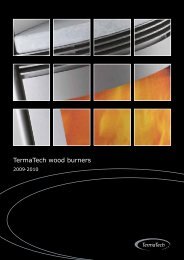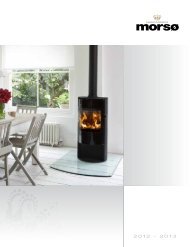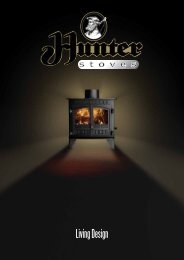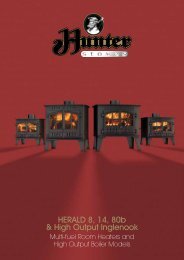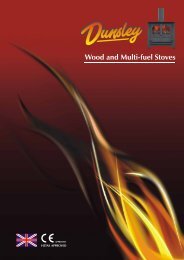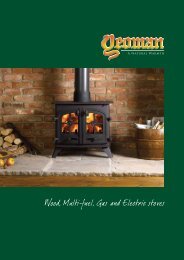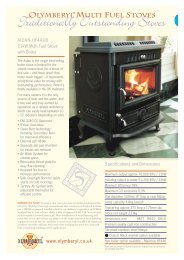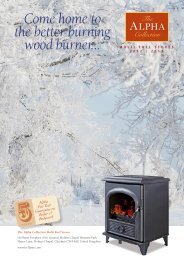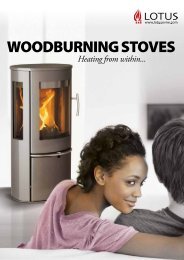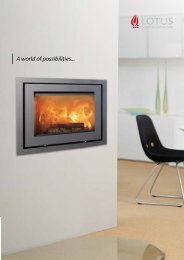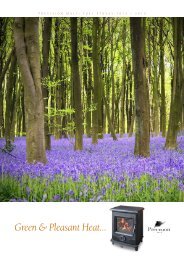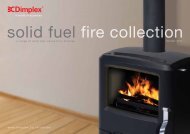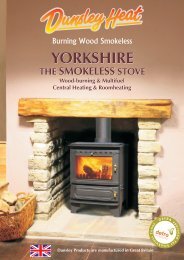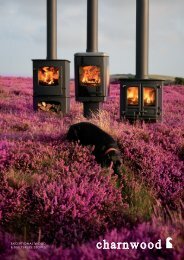Yeoman CL - The Stove Yard
Yeoman CL - The Stove Yard
Yeoman CL - The Stove Yard
- No tags were found...
Create successful ePaper yourself
Turn your PDF publications into a flip-book with our unique Google optimized e-Paper software.
USER INSTRUCTIONS5.12 Do not burn bituminous coal, ‘petro-coke’ or otherpetroleum based fuels, as this invalidates the productguarantee.Do not load fuel above the log guard and the secondarycombustion inlets at the back of the firebox(see Diagram 6).6. Burning tips6.1 Fuel Quality (Wood)Use wood with a moisture content of less than 20%.Seasoned logs have the bark beginning to lift and peel awayand cracks radiating from the centre. <strong>The</strong>y feel lighter thanfresh cut wood of a similar size and sound hollow whenstruck against each other. Logs should not feel damp orhave moss and fungal growths.Symptoms related to wet wood:—Difficulty starting and keeping a fire burning well.—Smoke and small flames.—Dirty glass and/or firebricks.—Rapid creosote build-up in the chimney.—Low heat output.—Short burn times, excessive fuel consumption andblue/grey smoke from the chimney.Burn at a high temperature for a short period each dayto avoid large build-ups of tars and creosote within theappliance and the flue system.Use Stovax Protector chimney cleaner to reduce thisproblem.6.2 Fuel Quality (Solid Fuel)Use recommended solid fuels approved for use with closedappliances.Symptoms related to unsuitable fuels include:—Difficulty starting and keeping a fire burning well.—Smoke and small flames.—Dirty glass and/or fire bricks.—Short life span for Grate, Baffle and internal Firebricks.—Permanent staining of glass.6.3 Air inlets puffing smokeCombustion gases can build up in the firebox and igniteas small explosions, causing smoke to puff out of the airinlets and other openings. This occurs if the air controlsare shut soon after adding new fuel to a very hot fire. Stopby opening the air controls to increase combustion air andburning rate.6.4 Flue Draught<strong>The</strong> chimney has two main functions:1) To safely remove the smoke, gases and fumes from thehouse.2) To provide a sufficient amount of draught (suction) in theappliance ensuring the fire keeps burning.Draught is caused by the rising hot air in the chimney whenthe appliance is lit.Symptoms of poor performance related to flue draughtinclude:—Excessive fuel consumption (high flue draught).—Poor burning control, overheating (high flue draught).—Wind noise from air controls (high flue draught).—Difficulty getting a fire going and keeping it burning well(low flue draught).—Low heat output (low flue draught).—Smoke entering room when doors opened (low fluedraught).<strong>The</strong> construction, position, size and height of the chimneyall affect the performance of the flue draught.Other factors effecting the flue draught include:—Trees or other buildings nearby causing turbulence.—Outside temperature.—Outside weather conditions.—Incorrect additional ventilation to building.—Blocked flue / chimney.For advice on the correction of persistent flue problemsconsult a qualified solid fuel heating engineer beforecontinuing to use the appliance.6.5 Weather conditions<strong>The</strong> weather conditions outside the building can effect theburning performance of the appliance. <strong>The</strong>se could include:Weather Conditions Problem EffectWindy daysBuildings/Obstaclescause turbulent airaround chimney.Smoky ApplianceCalm days Oversized Chimney. Smoky ApplianceDamp / Rainy daysFlue temperaturenot hot enough.Rain water insidechimney.To reduce these problems:Lighting andburning problems—Use good quality kindling wood to start the fire.—Burn initially at a high temperature for a short period.—Fit a rain cowl to the chimney.Your installer should advise you on possible solutions.If the appliance emits smoke into the room continuously:—Close the air controls and allow the appliance to go out.—Ventilate the room to clear the fumes.Do not re-light the appliance until the problem is solved.8



